Graceful Farewell: A Collection of 33 Probation Termination Letter Templates
Welcome to “Probation Termination Letters” – Your Ultimate Resource for Professionally Crafted Termination Communications! Navigating probationary can be challenging for employers, and effective communication during these delicate moments is paramount. At “Probation Termination Letters,” we are committed to providing you with a comprehensive collection of expertly designed tailored to various probationary circumstances. We understand the importance of maintaining positive relationships within your organization, and are designed to support you in making informed decisions while upholding company standards. With a focus on meeting your unique needs, our diverse range of probation is continuously updated and expanded to address evolving workplace challenges.
Comparison Guides
Comparison guides are an excellent way to provide valuable insights to potential customers and assist them in making informed decisions. Here are some tips for creating effective comparison guides:
- Identify Competitors: Research and identify key competitors in your industry whose products or services are similar to yours.
- Focus on Key Features: Highlight the essential features and functionalities of your products or services and compare them side by side with those of your competitors.
- Use Visuals: Incorporate visual elements such as tables, charts, or graphs to present the comparison data in a clear and easy-to-understand format.
- Be Objective: Ensure the comparison is unbiased and based on factual information to maintain credibility and trust.
- Highlight Unique Selling Points (USPs): Emphasize your product’s or service’s unique strengths and advantages over the competition.
- Address Limitations: Transparently address any limitations or weaknesses your offering may have in comparison to competitors.
- Provide Customer Testimonials: Include customer testimonials or reviews to validate your claims and demonstrate customer satisfaction.
- Offer Real-Life Examples: Share real-life scenarios or case studies where your product or service outperformed the competition.
- Keep it Concise: Present the comparison in a concise and easily scannable manner, so visitors can quickly grasp the key points.
- Link to Detailed Information: If needed, provide links to more comprehensive information, such as in-depth product pages or detailed reports.
- Update Regularly: Keep the comparison guides up-to-date to reflect any changes in your products, services, or the competitive landscape.
- Add CTAs: Include clear calls-to-action (CTAs) at the end of the comparison guide to encourage visitors to take the next step, such as contacting you or making a purchase.
How-To Guides and Tutorials
Some tips for creating effective guides and tutorials:
- Identify Audience Needs: Understand your target audience and their pain points. Research what topics or skills they are seeking to learn and create content that addresses their specific needs.
- Choose Relevant Topics: Select topics that are directly related to your industry or niche. Focus on areas where you have expertise and can offer valuable insights.
- Break it Down Step-by-Step: Organize the content clearly and logically, presenting information in a step-by-step format. Use bullet points, numbered lists, and subheadings to make it easy for readers to follow.
- Use Visuals: Incorporate visuals such as images, screenshots, or diagrams to enhance understanding. Visual aids can clarify complex concepts and make the tutorial more engaging.
- Keep it Concise and Clear: Avoid unnecessary jargon and keep the language simple and easy to understand. Be concise and get straight to the point.
- Include Examples and Case Studies: Provide real-life examples or case studies to illustrate the application of the tutorial. This can help readers relate the information to practical situations.
- Offer Practical Tips: Include practical tips, tricks, or best practices that readers can implement immediately.
- Address FAQs: Anticipate common questions that readers might have and address them within the guide or tutorial.
- Promote Interactivity: If applicable, encourage readers to engage with the content through interactive elements like quizzes, exercises, or challenges.
- Encourage Feedback and Discussion: Allow readers to leave comments or ask questions at the end of the tutorial. Engage with their feedback and provide helpful responses.
- Optimize for SEO: Use relevant keywords in the title and content to improve search engine visibility and attract more readers.
- Update and Maintain: Periodically review and update your guides and tutorials to ensure they stay relevant and accurate.
#1: Formal Probation Termination
A Formal Probation Termination Letter is a formal document issued by an employer to notify an employee that their probationary period has ended, and unfortunately, their employment is being terminated. This letter is used when an employee fails to meet performance standards, adapts to company culture, or violates policies during probation. It explains the reasons for termination, expresses regret, and provides details on a final paycheck, benefits, and paperwork for a smooth transition. This serves as an official notice while maintaining professionalism.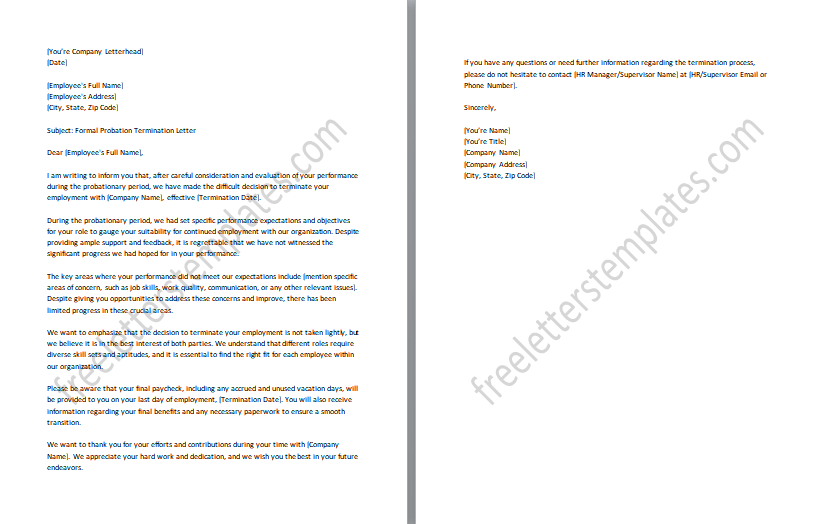
#2: Extended Probation Period Termination
An Extended Probation Period Termination Letter is an official notice sent by an employer. It informs the employee that their extended probationary period has ended. It occurs due to unsatisfactory performance or failure to meet required standards during the extended period. The letter expresses regret for the decision and provides details on a final paycheck, benefits, and necessary paperwork for a smooth transition. It maintains a professional tone while formally notifying the employee of their termination.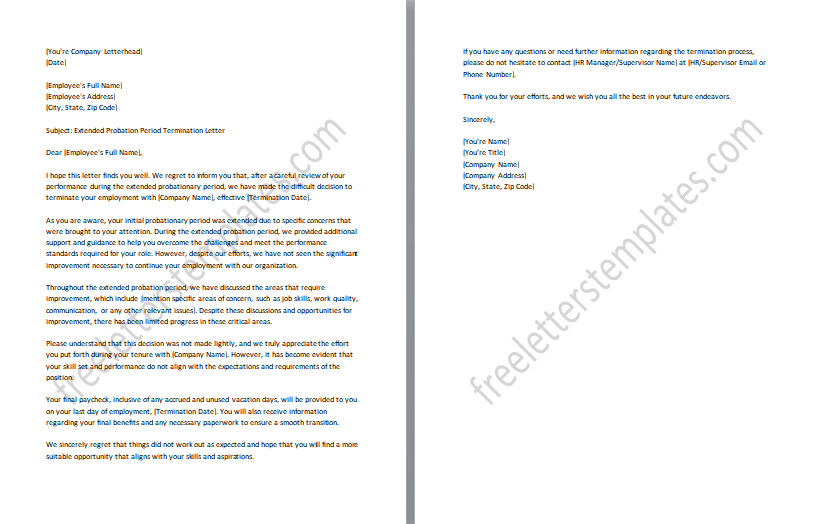
#3: Performance Improvement Plan (PIP) Termination
A Performance Improvement Plan (PIP) Letter is a formal notice of employment termination. It follows an unsuccessful completion of a PIP, which aims to help employees improve their performance. If the employee fails to meet the required improvements within the specified timeframe, this letter informs them of their termination. It outlines the reasons, expresses regret, and provides details on a final paycheck, benefits, and paperwork for a smooth transition. The letter maintains professionalism and transparency in the process.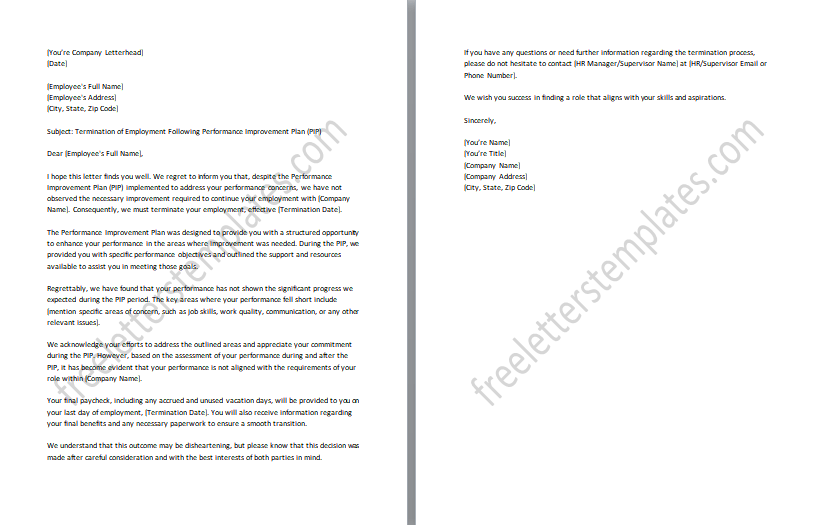
#4: Behavioral Probation Dismissal
A Behavioral Probation Dismissal Letter is an official notice of employment termination. It is sent when an employee displays disruptive behavior or violates company policies during their probationary period. The letter outlines the reasons for termination, expresses regret, and provides details on a final paycheck, benefits, and paperwork for a smooth transition. It maintains professionalism while addressing specific behavioral concerns that led to the decision.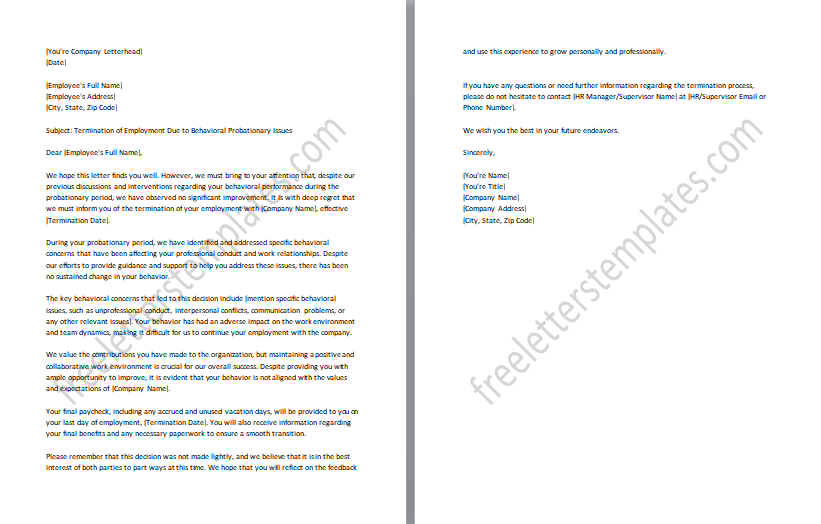
#5: Attendance Probation Termination Notice
An Attendance Probation Notice is a formal notice of employment termination. It is sent when an employee has attendance-related issues during their probationary period. The letter cites reasons for termination, expresses regret, and provides details on a final paycheck, benefits, and paperwork for a smooth transition. It maintains professionalism while addressing specific attendance concerns that led to the decision.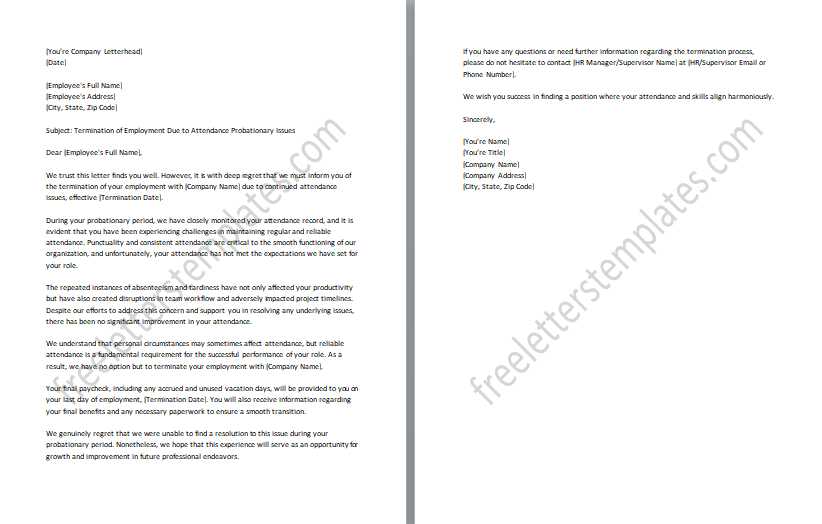
#6: Skills Development Probation Closure
A Skills Development Probation Closure Letter is an official notice of the end of an employee’s probationary period. It is sent after the employee completes a skills development program. The letter congratulates the employee for meeting the required improvement and competence. It outlines the next steps in their career progression within the organization. This serves as a positive and encouraging confirmation of the employee’s progress and commitment to professional development.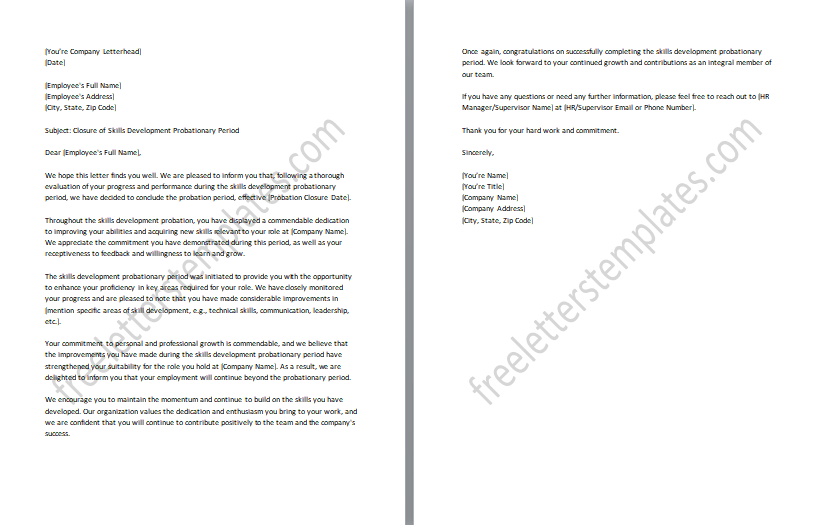
#7: Policy Violation Probation Discharge
A Policy Violation Probation Discharge Letter is when the employer informs an employee that their probationary period is ending due to serious policy violations. It happens when an employee breaches company policies or ethical guidelines, harming the organization’s reputation. The letter cites the specific violations, expresses regret, and provides details for the transition. It’s a formal notice of termination, reminding us of the importance of following policies.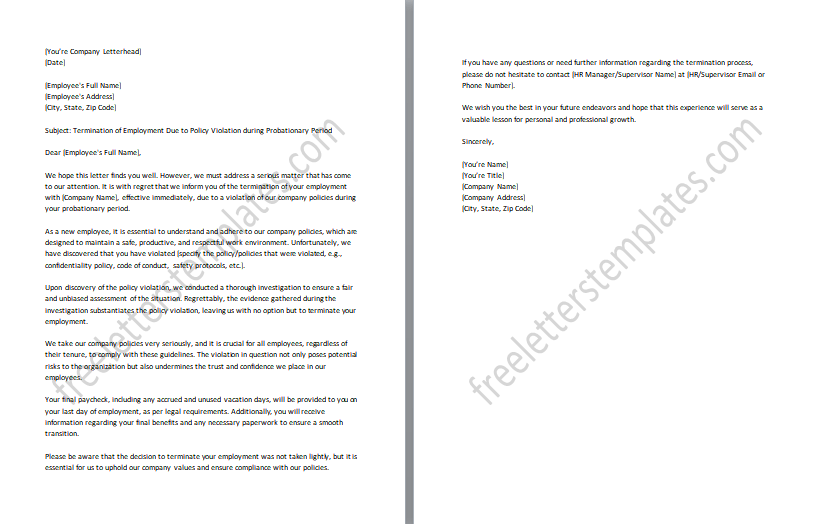
#8: Failure to Meet Performance Objectives Termination
The Failure to Meet Performance Objectives Termination Letter is a crucial communication from the employer to an employee, signaling the end of their employment due to not meeting performance expectations during probation. It expresses regret, outlines the final paycheck and benefits, and stresses the importance of meeting objectives for individual and organizational success. The letter encourages personal growth and improvement in future roles.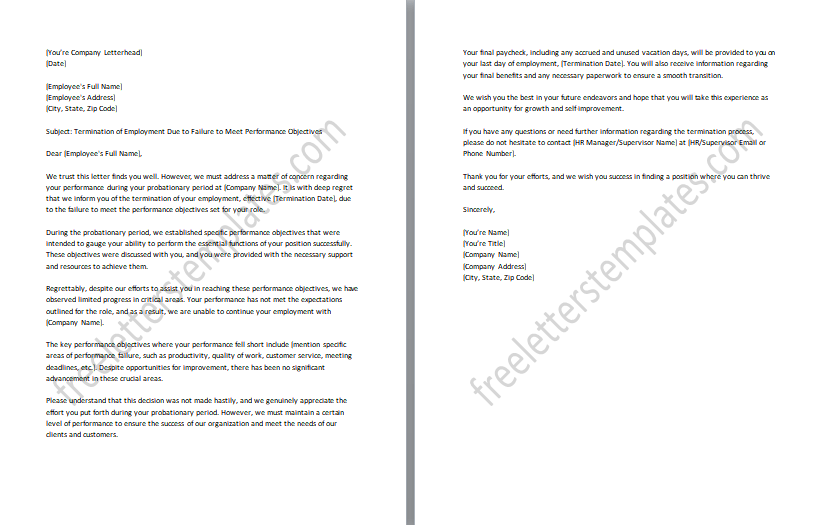
#9: Lack of Progress Probation Dismissal Letter
The Lack of Progress Probation Dismissal Letter is sent by an employer to terminate an employee due to insufficient improvement during probation. It notifies the employee of their termination when they fail to meet the expected progress, growth, or skill development within the probationary period. The letter expresses regret for the decision and outlines the final paycheck, benefits, and transition details. It emphasizes the significance of demonstrating progress and development during probation. It serves as a formal notice of termination while maintaining professionalism and underlining the importance of meeting expectations during the probationary phase.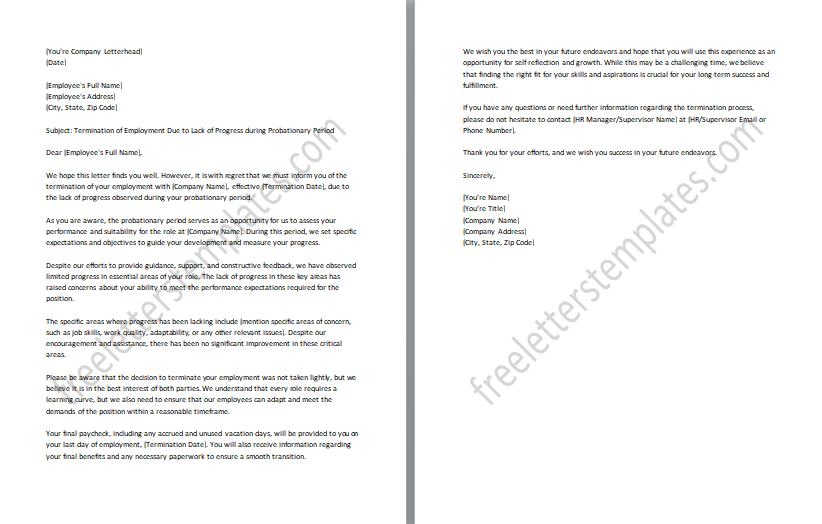
#10: Misconduct Probation Termination Notice
The Misconduct Probation Termination Notice is an official communication from the employer to inform an employee about their misconduct during their probationary period. The letter highlights specific instances of behavior that violate company policies or ethical standards, resulting in significant harm to the organization. With regret, it notifies the employee of the decision while offering information regarding their final paycheck, benefits, and the transition process. This formal notice of termination underscores the importance of upholding ethical and behavioral standards in the workplace.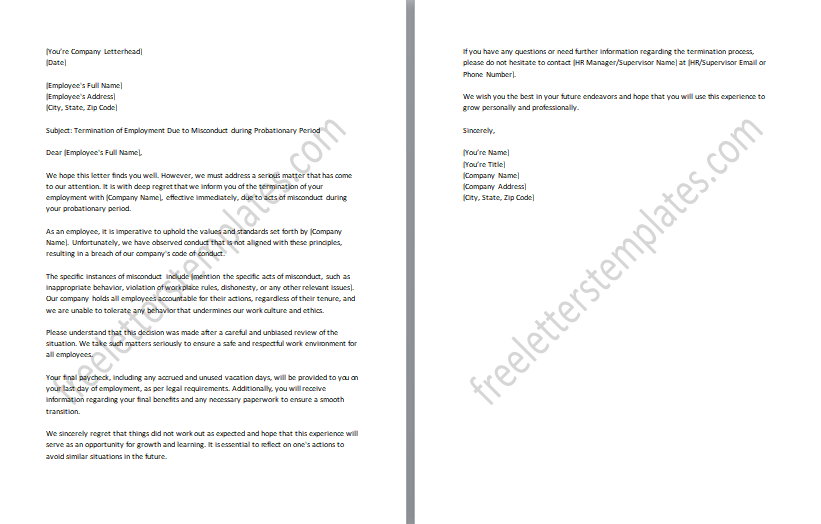
#11: Insubordination Probation Discharge
The Insubordination Probation Discharge Letter is sent to terminate an employee for insubordination during probation. It cites specific instances of refusal to follow instructions or disrespectful behavior towards superiors. The letter expresses regret for the decision and outlines the final paycheck, benefits, and transition details. It serves as a formal notice of termination, emphasizing the importance of respecting authority and fostering effective communication within the organization.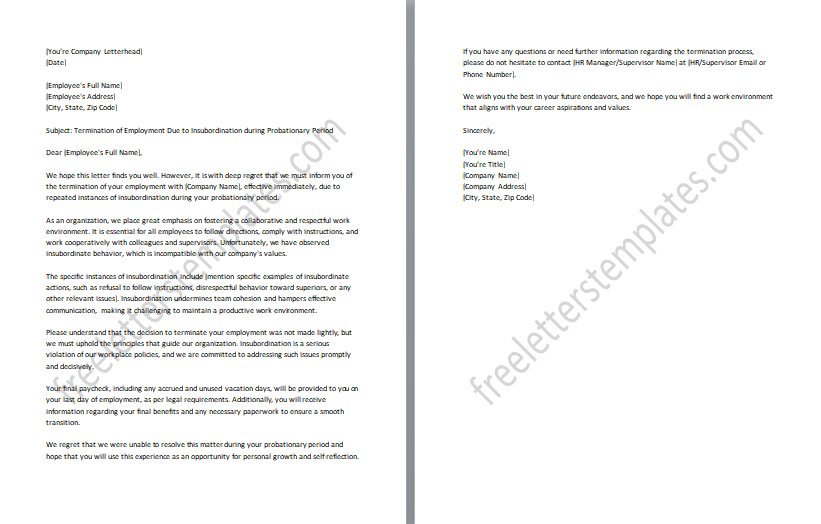
#12: Code of Conduct Violation Termination
The Code of Conduct Violation Termination Letter informs an employee for violating the company’s code of conduct during probation. It cites specific breaches of ethical guidelines or policies. The letter expresses regret and provides details on a final paycheck, benefits, and transition. It emphasizes upholding the organization’s ethical standards and values. It is a formal notice of termination while maintaining professionalism.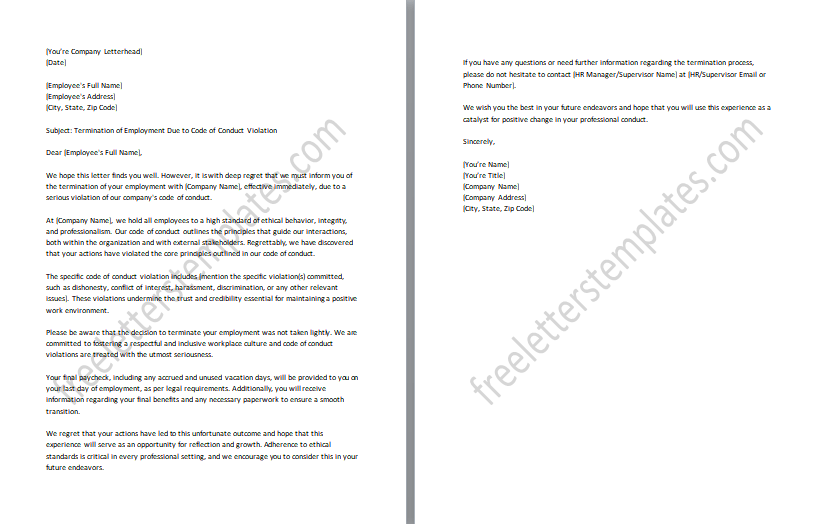
#13: Repeated Errors Probation Termination Notice
The Repeated Errors Probation Termination Notice is a formal communication from the employer to inform the employee about their termination due to persistent errors during their probationary period. This letter is used when the employee has been consistently making mistakes or failing to improve their performance, despite receiving guidance and support. It outlines the specific instances of repeated errors, expressing regret for the difficult decision. Additionally, it provides information regarding the final paycheck, benefits, and any necessary paperwork for a smooth transition. This emphasizes the importance of meeting performance standards and learning from mistakes for personal growth and professional development.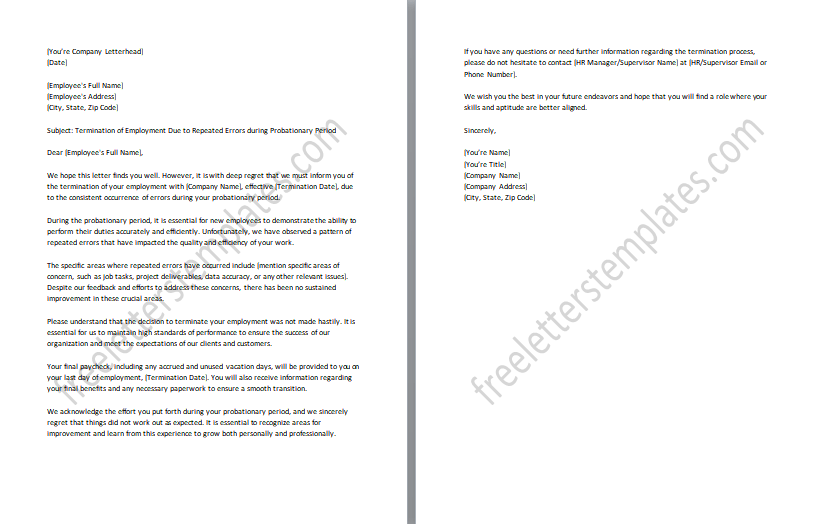
#14: Non-Compliance with Training Requirements Termination
The Non-Compliance with Training Requirements Termination Letter informs an employee of their not meeting training requirements during probation. It cites specific instances of failure to complete mandatory training or demonstrate acquired skills. This expresses regret and provides details on a final paycheck, benefits, and transition. It serves as a formal notice of termination, emphasizing the importance of training to enhance job performance and contribute to the organization’s success. The letter maintains professionalism in addressing the non-compliance issue.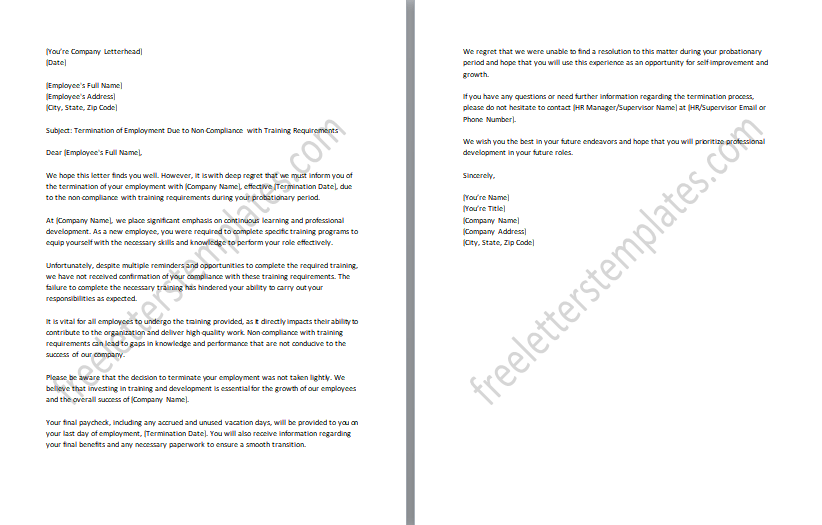
#15: Job Abandonment Probation Dismissal Letter
The Job Abandonment Probation Dismissal Letter notifies an employee of termination due to job abandonment during probation. It cites extended absences without valid reasons or communication. The letter expresses regret and outlines the final paycheck, benefits, and transition details. It serves as a formal notice of termination, emphasizing the importance of fulfilling job responsibilities and maintaining open communication. This maintains professionalism while addressing the issue of job abandonment.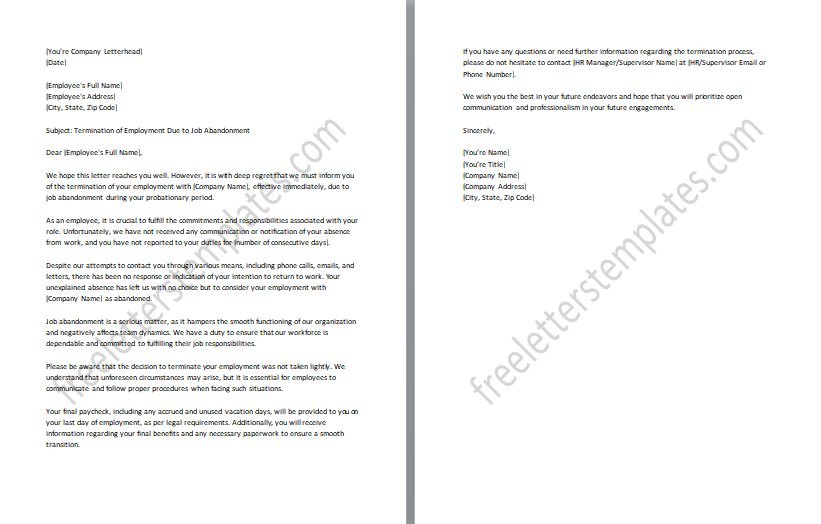
#16: Safety Policy Violation Termination Notice
The Safety Policy Violation Termination Notice is sent to terminate an employee for violating safety policies during their employment. It cites specific instances of breaching safety guidelines or procedures, jeopardizing the well-being of themselves or others. The letter expresses regret for the decision and outlines the final paycheck, benefits, and transition details. It serves as a formal notice of termination, emphasizing the importance of adhering to safety policies for the welfare of everyone in the workplace. The letter maintains professionalism while addressing the serious nature of safety violations.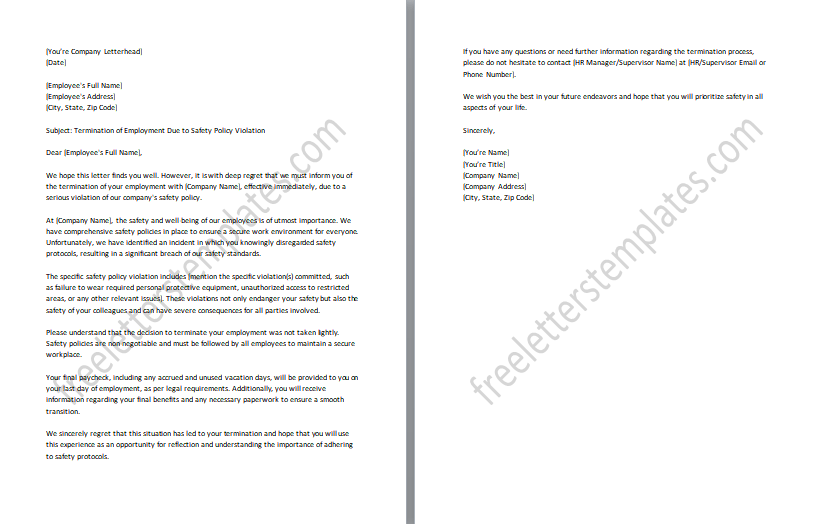
#17: Confidentiality Breach Probation Termination
The Confidentiality Breach Probation Termination Letter informs an employee for breaching confidentiality during probation. It cites specific instances of unauthorized disclosure of sensitive information. This expresses regret and provides details on a final paycheck, benefits, and transition. It serves as a formal notice of termination, emphasizing the critical importance of safeguarding confidential information. The letter maintains professionalism while addressing the severity of the confidentiality breach.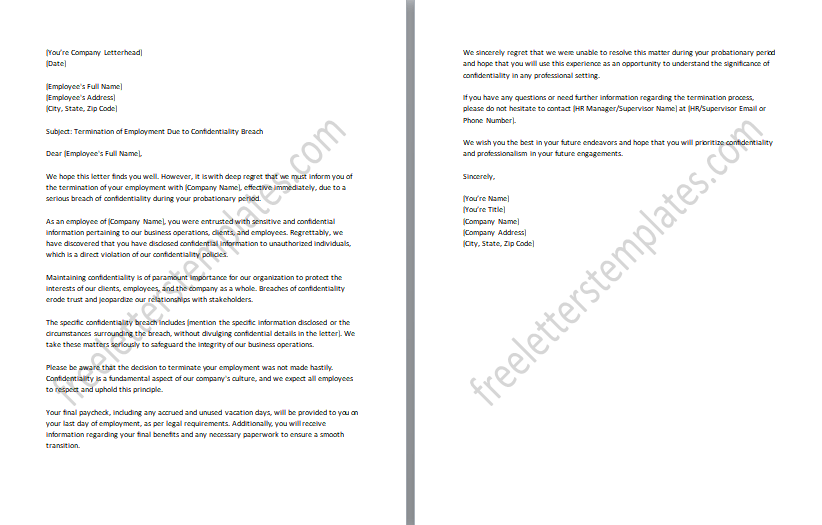
#18: Data Security Policy Violation Termination Letter
The Data Security Policy Violation Termination Letter informs an employee for breaching data security policies during probation. It cites specific instances of mishandling or unauthorized access to sensitive data. This expresses regret and provides details on a final paycheck, benefits, and transition. It serves as a formal notice of termination, emphasizing the critical importance of adhering to data security protocols. The letter maintains professionalism while addressing the severity of the policy violation.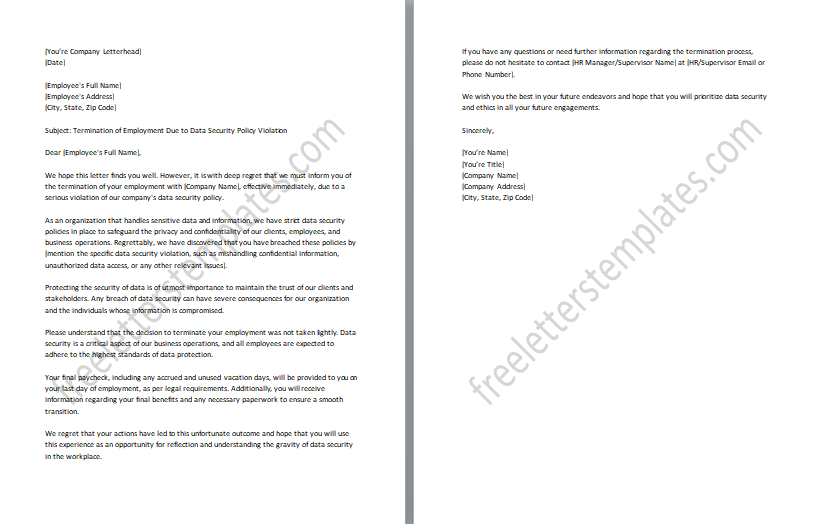
#19: Falsification of Records Probation Discharge Letter
The Falsification of Records Probation Discharge Letter informs an employee of termination for falsifying records during probation. It cites specific instances of providing false information or misrepresenting data. It expresses regret and outlines the final paycheck, benefits, and transition details. It serves as a formal notice of termination, emphasizing the importance of maintaining integrity and honesty in all aspects of work. The letter maintains professionalism while addressing the severity of the falsification of records.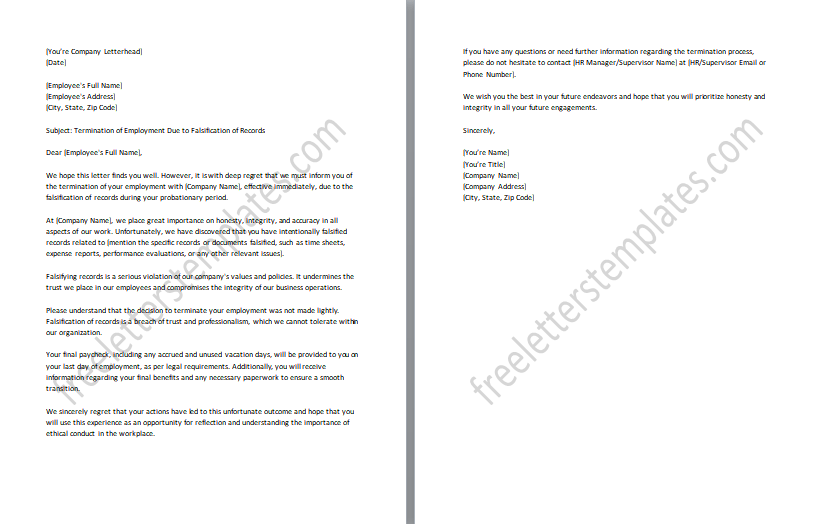
#20: Unethical Behavior Probation Termination Notice
The Unethical Behavior Probation Termination Notice informs an employee for engaging in unethical behavior during probation. It cites specific instances of violating ethical standards or company values. The letter expresses regret and provides details on a final paycheck, benefits, and transition. It serves as a formal notice of termination, emphasizing the importance of upholding ethical principles and fostering a positive work culture. The letter maintains professionalism while addressing the seriousness of unethical behavior.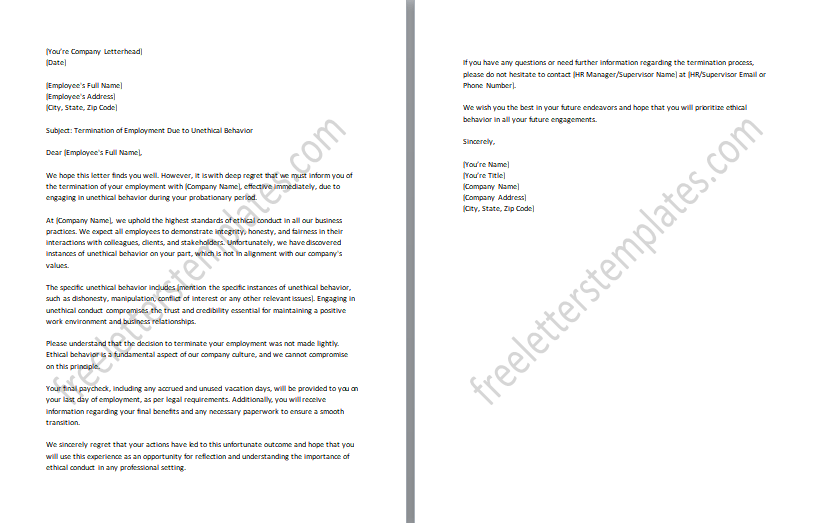
#21: Harassment or Discrimination Probation Dismissal Letter
The Harassment or Discrimination Probation Dismissal Letter informs an employee of termination for engaging in harassment or discrimination during probation. It cites specific instances of offensive or discriminatory behavior. This expresses regret and outlines the final paycheck, benefits, and transition details. It serves as a formal notice of termination, emphasizing the company’s commitment to a respectful and inclusive workplace. The letter maintains professionalism while addressing the seriousness of harassment or discrimination.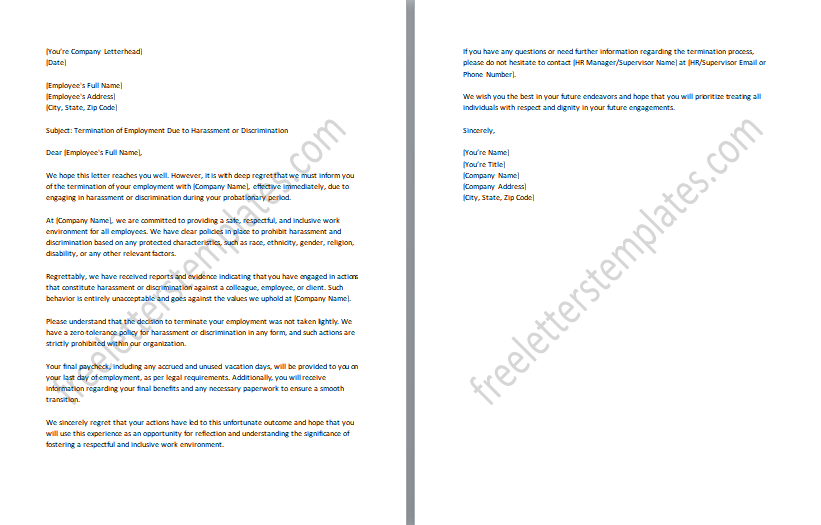
#22: Substance Abuse Policy Violation Termination Letter
The Substance Abuse Policy Violation Termination Letter notifies an employee for violating the company’s substance abuse policy. It cites instances of drug or alcohol misuse during employment. It expresses regret and provides details on a final paycheck, benefits, and transition. It serves as a formal notice of termination, emphasizing the importance of adhering to the substance abuse policy for a safe and productive work environment. The letter maintains professionalism while addressing the seriousness of the policy violation.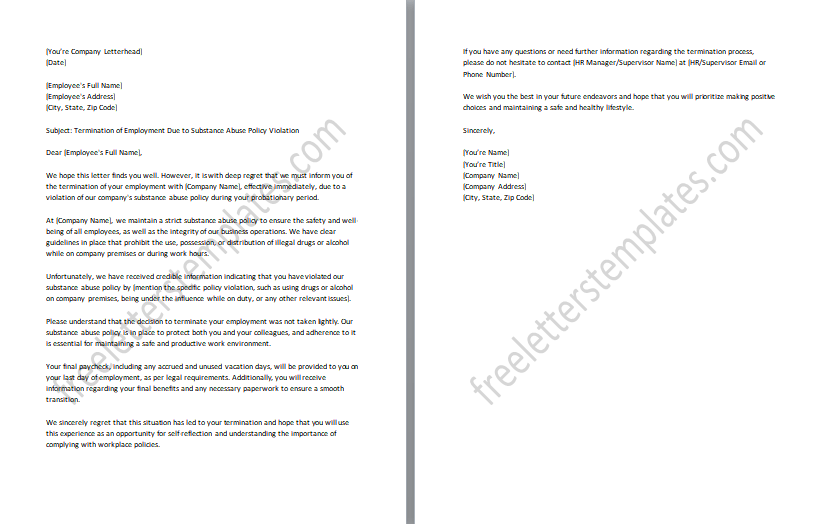
#23: Conflict of Interest Probation Termination Notice
The Conflict of Interest Probation Termination Notice informs an employee for engaging in a conflict of interest during probation. It cites specific instances of activities conflicting with company interests. The letter expresses regret and provides details on a final paycheck, benefits, and transition. It serves as a formal notice of termination, emphasizing the importance of avoiding conflicts of interest for fair business practices. The letter maintains professionalism while addressing the seriousness of the conflict of interest issue.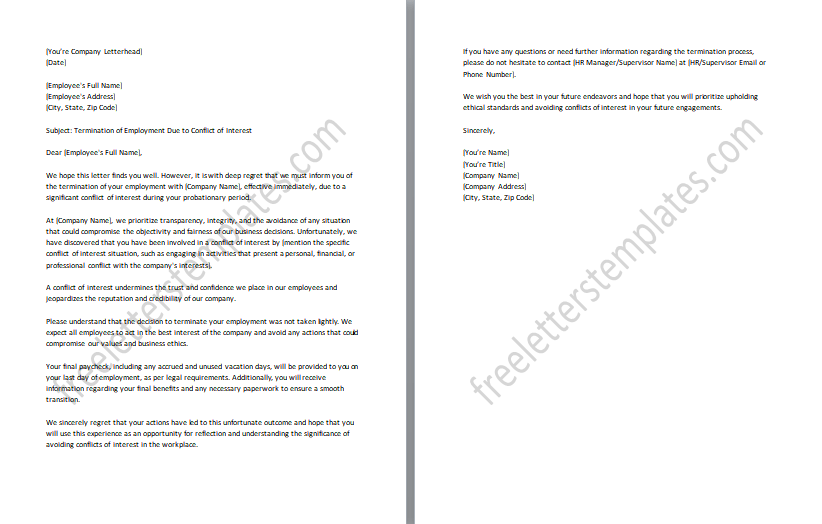
#24: Inadequate Communication Skills Termination
The Inadequate Communication Skills Termination Letter is an official communication sent by an employer to inform an employee that their employment is being terminated due to inadequate communication skills during their probationary period. This letter is used when an employee’s communication abilities hinder effective collaboration, understanding, and workflow within the organization. It outlines the specific instances of inadequate communication, expresses regret for the decision, and provides information regarding the final paycheck, benefits, and any necessary paperwork for a smooth transition. This serves as a formal notification of termination while maintaining professionalism and highlighting the significance of strong communication skills for successful job performance and maintaining a cohesive work environment.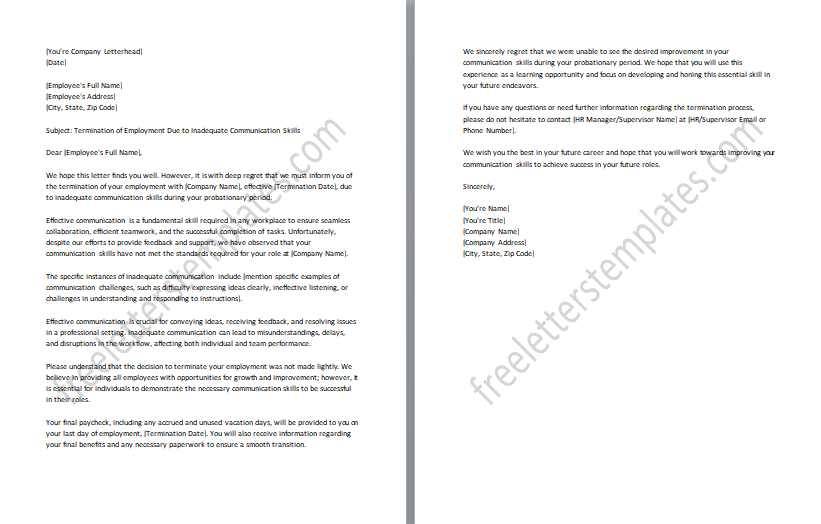
#25: Poor Interpersonal Relationships Probation Discharge Letter
The Poor Interpersonal Relationships Probation Discharge Letter informs an employee due to poor interpersonal relationships during probation. It cites specific instances of negative behavior affecting colleagues and team dynamics. This expresses regret and outlines the final paycheck, benefits, and transition details. It serves as a formal notice of termination, emphasizing the importance of fostering positive relationships in a collaborative workplace. The letter maintains professionalism while addressing the issue of poor interpersonal relationships.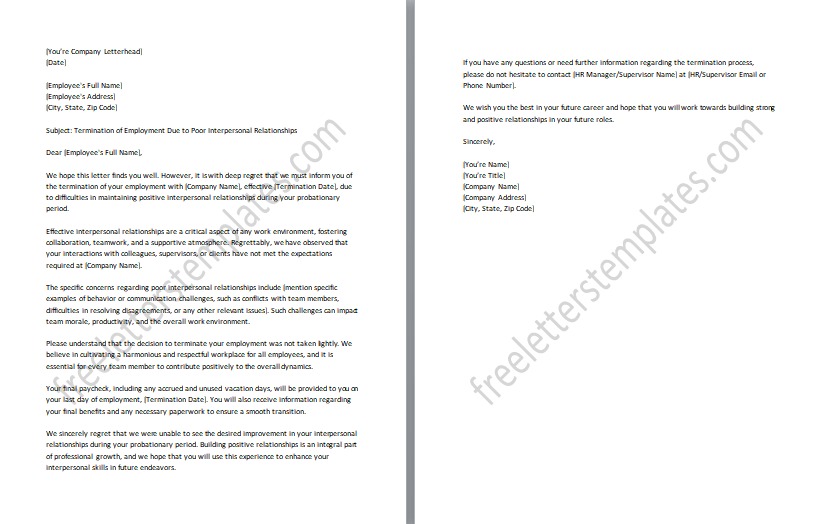
#26: Failure to Follow Instructions Termination Notice
The Failure to Follow Instructions Termination Notice informs an employee for consistently not following instructions during probation. It cites specific instances of disregarding directives or tasks. The letter expresses regret and provides details on a final paycheck, benefits, and transition. It serves as a formal notice of termination, emphasizing the importance of attentiveness and compliance in carrying out job responsibilities effectively. The letter maintains professionalism while addressing the issue of failure to follow instructions.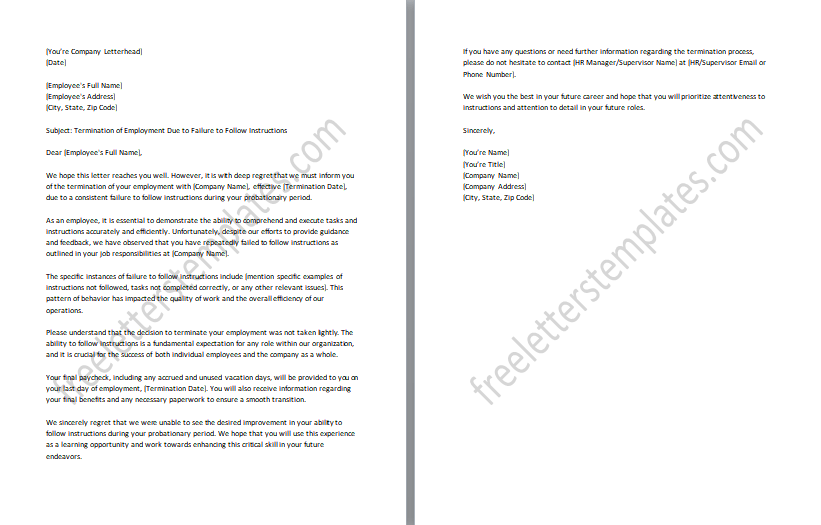
#27: Work Schedule Violation Probation Termination Letter
The Work Schedule Violation Probation Termination Letter informs an employee for violating the work schedule during probation. It cites specific instances of failing to adhere to designated work hours or arriving late. This expresses regret and provides details on a final paycheck, benefits, and transition. It serves as a formal notice of termination, emphasizing the importance of punctuality and adhering to the work schedule for an efficient workplace. The letter maintains professionalism while addressing the issue of work schedule violations.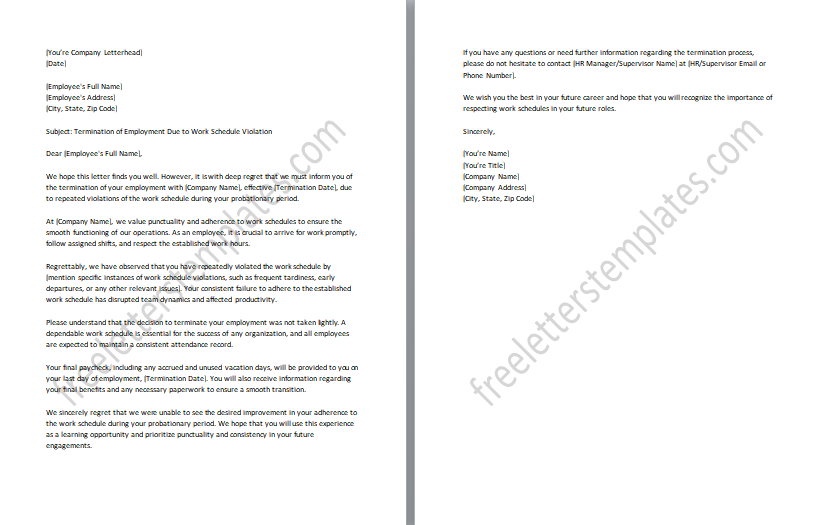
#28: Failure to Adapt to Company Culture Termination Letter
The Failure to Adapt to Company Culture Termination Letter is sent to terminate an employee for not fitting into the company culture during probation. It cites specific instances of struggling to align with the organization’s values and work environment. This expresses regret for the decision and outlines the final paycheck, benefits, and transition details. It serves as a formal notice of termination, emphasizing the importance of cultural fit for a cohesive and harmonious workplace. The letter maintains professionalism while addressing the issue of failure to adapt to the company culture. It encourages the employee to seek roles that align better with their values and strengths while reiterating the significance of cultural alignment for the organization’s success.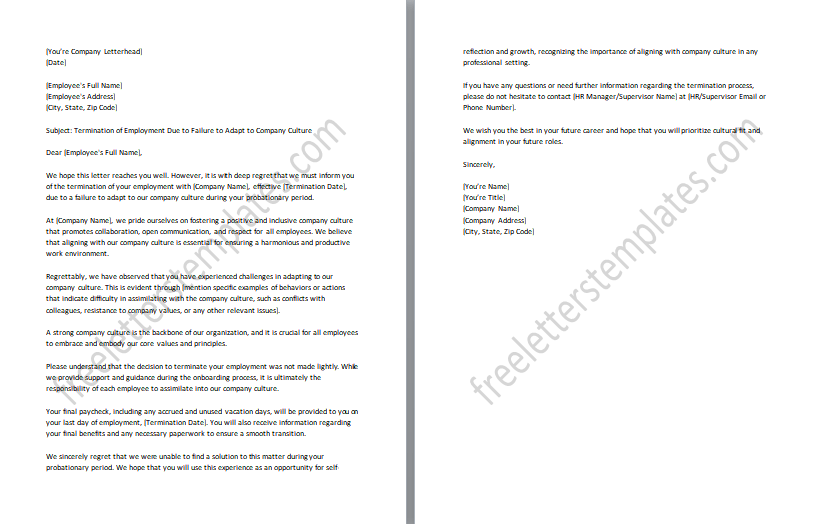
#29: Unsatisfactory Customer Service Probation Dismissal Letter
The Unsatisfactory Customer Service Probation Dismissal Letter informs an employee of termination for unsatisfactory customer service during probation. It cites specific instances of not meeting expected service standards, resulting in customer complaints and dissatisfaction. This expresses regret and outlines the final paycheck, benefits, and transition details. It serves as a formal notice of termination, emphasizing the importance of delivering excellent customer service for customer satisfaction and loyalty. The letter maintains professionalism while addressing the issue of unsatisfactory customer service.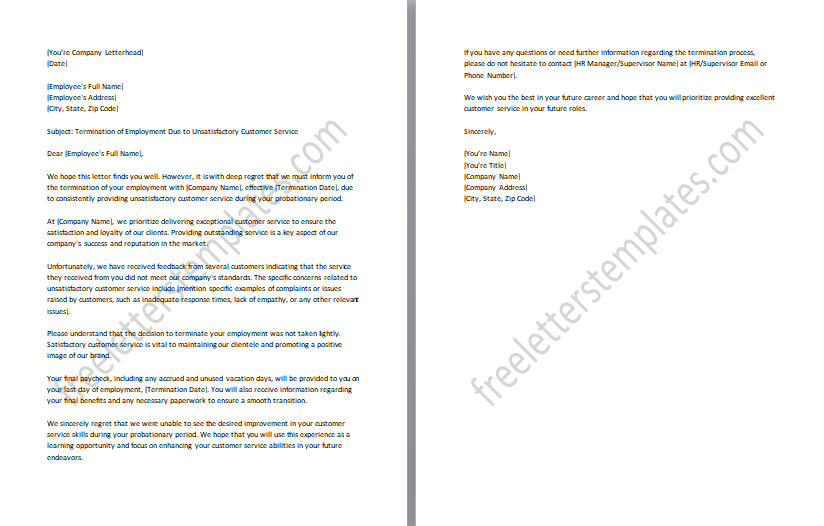
#30: Breach of Client Confidentiality Termination Notice
The Breach of Client Confidentiality Termination Notice informs an employee for breaching client confidentiality during probation. It cites specific instances of disclosing sensitive client information without authorization. The letter expresses regret and provides details on a final paycheck, benefits, and transition. It serves as a formal notice of termination, emphasizing the critical importance of maintaining client confidentiality and trust. The letter maintains professionalism while addressing the seriousness of the confidentiality breach.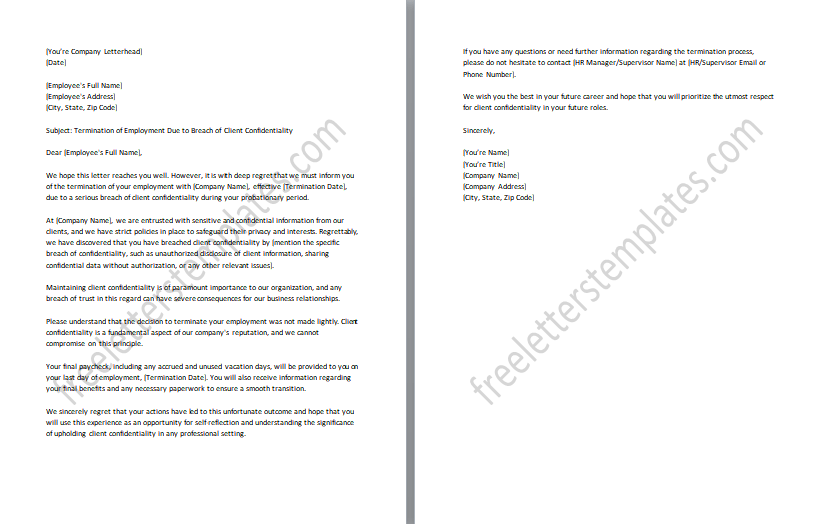
#31: Incomplete Assigned Tasks Probation Termination
The Incomplete Assigned Tasks Probation Termination Letter is sent to terminate an employee for consistently failing to complete assigned tasks during probation. It cites specific instances of unfinished work or missed deadlines. It expresses regret and outlines the final paycheck, benefits, and transition details. It serves as a formal notice of termination, emphasizing the importance of fulfilling responsibilities and meeting deadlines. This maintains professionalism while addressing the issue of incomplete tasks. It encourages the employee to reflect on their performance and use the experience to improve in future roles.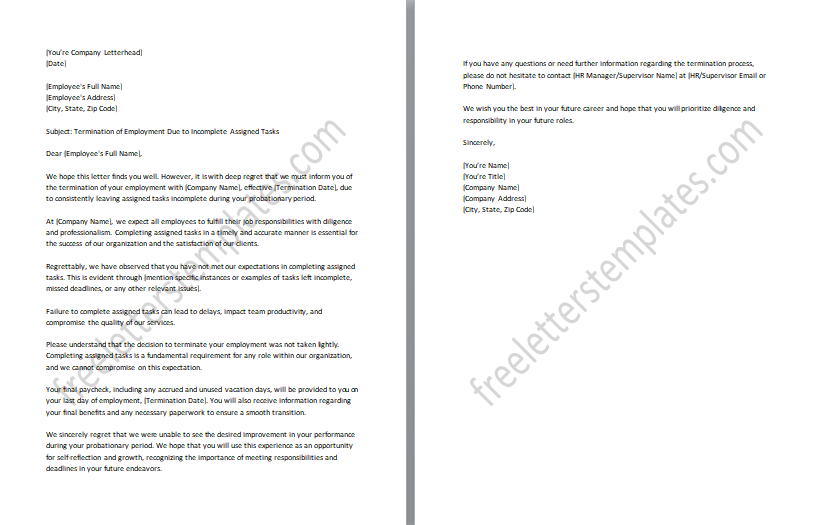
#32: Violation of Equipment Use Policies Termination
The Violation of Equipment Use Policies Termination Letter informs an employee for violating equipment use policies during probation. It cites specific instances of misusing or mishandling company equipment. It expresses regret and outlines the final paycheck, benefits, and transition details. It serves as a formal notice of termination, emphasizing the importance of adhering to equipment use policies for safety and asset protection. The letter maintains professionalism while addressing the issue of equipment use violations.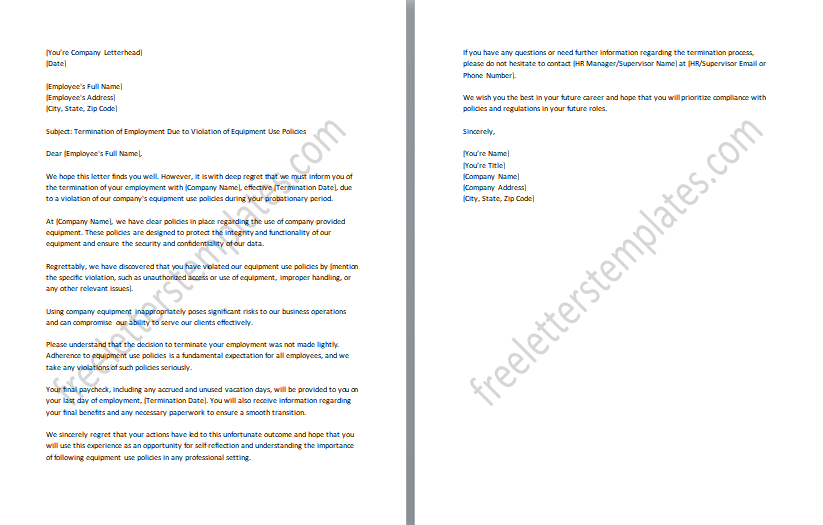
#33: Failure to Uphold Quality Standards Probation Discharge
The Failure to Uphold Quality Standards Probation Discharge Letter informs an employee of termination for not meeting quality standards during probation. It cites specific instances of subpar work affecting products or services. This expresses regret and outlines the final paycheck, benefits, and transition details. It serves as a formal notice of termination, emphasizing the importance of maintaining high-quality standards for customer satisfaction and organizational success. It maintains professionalism while addressing the issue of failure to uphold quality standards.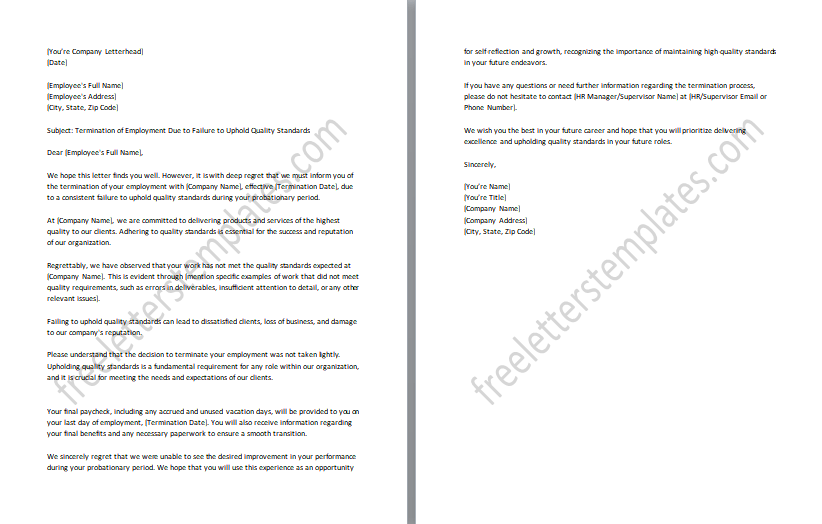
Offer Practical Tips
- Use Bullet Points: Present tips in concise bullet points or numbered lists for easy readability and quick implementation.
- Highlight Key Takeaways: Bold or italicize key tips to draw attention to important points.
- Provide Real-Life Examples: Accompany tips with real-life examples to illustrate how they can be applied in different situations.
- Offer Quick Fixes: Include quick and actionable tips that readers can implement immediately to address common challenges or problems.
- Suggest Tools and Resources: Recommend relevant tools, apps, or resources that can assist readers in implementing the tips effectively.
- Break Down Complex Concepts: Simplify complex concepts into actionable steps, making it easier for readers to follow through.
- Encourage Small Changes: Suggest small, manageable changes that readers can make gradually to see significant improvements over time.
- Share Expert Insights: If possible, incorporate insights from industry experts or successful individuals to inspire readers and offer valuable advice.
- Address Common Mistakes: Warn readers about common pitfalls and provide tips to avoid or overcome them.
- Encourage Feedback: Invite readers to share their experiences with implementing the tips and encourage them to provide feedback or additional suggestions.
- Create Checklists: Provide downloadable checklists or action plans to help readers organize and track their progress.
- Link to Additional Resources: Include links to relevant articles, videos, or tutorials that provide further insights on specific topics.
- Offer Step-by-Step Instructions: Break down more complex tips into clear step-by-step instructions, making it easier for readers to follow along.
- Consider Different Skill Levels: Offer tips suitable for readers with varying levels of expertise, from beginners to advanced practitioners.
- Stay Current: Continuously update your tips and practices to reflect the latest industry trends and developments.
Interactive Tools or Quizzes
- Industry-specific Quizzes: Create fun and informative quizzes that test your audience’s knowledge about your industry or niche. For example, you can have a “How Well Do You Know [Your Industry]?” quiz.
- Personality Assessments: Design personality assessments that align with your industry or the products/services you offer. This can help visitors discover how their personality traits relate to specific aspects of your industry.
- Savings Calculator: If your business is related to finance or saving money, consider building a savings calculator that allows users to input their data and receive personalized savings tips.
- Health and Wellness Checklists: If you’re in the health and wellness industry, create interactive checklists to help users track their wellness goals or habits.
- Product Recommender: Develop a product recommender tool that asks users a series of questions to recommend the best-suited products or services from your offerings.
- Educational Simulations: For industries that involve complex processes or concepts, consider building educational simulations that allow users to interact and learn through virtual experiences.
- Competency Assessments: If you’re in the education or training sector, offer competency assessments that gauge the users’ skill levels in specific subjects or areas.
- Style or Personality Quizzes: If your industry is related to fashion, beauty, or lifestyle, create interactive quizzes to help users discover their unique style or personality traits.
- Sustainability Calculator: Develop a calculator that allows users to assess their carbon footprint or sustainability efforts, providing tips to reduce environmental impact.
- Time Management Tool: Create an interactive time management tool that helps users organize their daily tasks and schedules efficiently.
- Nutrition Planner: For the food and nutrition industry, offer an interactive meal planner that helps users create personalized, healthy meal plans.
- Career Path Quiz: If you offer career-related services or products, design a quiz that guides users to potential career paths based on their interests and skills.
Conclusion Thoughts:
We’re delighted to present “Probation Termination Letters,” a dedicated resource offering a wide range of professionally crafted terminations tailored to various probationary situations. Our heartfelt mission is to support employers like you in handling matters with clarity, empathy, and a touch of professionalism.
We truly understand the complexities that come with probationary and the importance of effective communication during such delicate moments. That’s why our primary goal is to provide you with practical and impactful resources, assisting you in navigating these challenges while upholding legal and ethical standards. With “Probation Termination Letters” by your side, you can approach these tough situations with confidence, knowing you have well-crafted tools that prioritize fairness and understanding.